

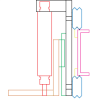
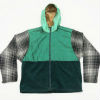
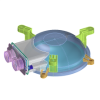
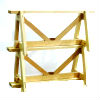
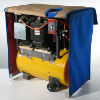
I think tensioned fabric forms offer a highly scalable way of architectural-scale structures
Frei Otto was an early pioneer in tension structures
My favorite examples of fabric architecture come from the Lithuanian-born artist Alexandra Kasuba, who constructed evocative interior environments out of double stretch nylon knit, which she sewed on an overlock machine.
Tensile architecture is now a large, mature industry, and there are now a wide range of textiles available for this purpose. Tensinet is one of a number of industry consortiums that brings together architects, engineers, suppliers, and contractors.
Impressive as modern large-scale fabric constructions are, I see a unique sensibility and a level of sculptural intrigue in Aleksandra Kasuba's constructions that has scant representation in the mainstream tensile industry. Most modern tensile constructions serve to cover outdoor pavilions, stadiums, etc. Having researched a large number of projects like this, I am surprised at the relative absence of topological exploration: that is, I don't see anyone working with hollow spaces and cavities. There's plenty of sun shades, but I haven't seen any elastic nylon caves being constructed for gymnasiums, playgrounds, obstacle courses, or dance performances. This seems like a logical - albeit moderately eccentric - application for architectural fabric.
Kasuba created the website curvedsurfaces.com to document the processes by which she arrived at her installations.
One surprising aspect of the process is how simple the underlying flat patterns are. Underneath the compound curves, in most cases, are straight lines. She achieves more lyrical configurations by stretching them over armatures. She conceived her installations using scale models, and worked playfully, inventing the shapes in-real-life.
In contrast, the mainstream of tensile construction designs structures using finite element analysis and formfinding algorithms. The resulting structures appear elastic, but in fact are rigid. The structures are pulled taut on a framework, but all of the eventual curvature is present from the beginning. The panel shapes, in this, start out as complex shapes, and can only be pulled into one one, specific configuration.
The professional approach is all planning, with little play. This is obviously necessary, for many projects, but for many others, it isn't.
When Frei Otto made these
The barriers-to-entry for the Kasuba method are refreshingly approachable. A suitable overlocker machine (serger) is $250. Sewing stretchy knits with a serger is like welding with a MIG welding machine. It is fast, and forgiving. The machine will iron over a certain level of imprecision, so you don't need to be an expert operator for many applications. The serger cuts and hems the fabric as you go. The seams themselves also stretch.
Drafting patterns for Kasuba-style structures is also a categorically simpler affair than the FEA approach used by engineers. It can be done in 2 dimensions, without employing an 3D sophistiction.
The Kangaroo plugin for Rhino's Grasshopper is a popular tool that allow the user to easily arrive at minimal-surface structures using a form-finding algorithm. This tool does, in software, what Frei Otto did by stretching soap films over wire frames. The form emerges, automatically.
This is a distinctly different approach than that taken by firms you'd find through Tensinet. The curved seams in those structures start out curved: although the structures look elastic, they are in fact rigid.
The two approaches are opposite ways of arriving at forms that look superficially the same. Kasuba's flat patterns are straight lines